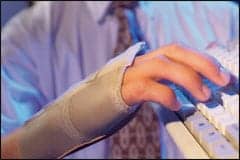By Mary Lynn Jacobs, MS OTR/L, CHT
When viewed from an emergency department, the beautiful firework displays of Independence Day can become a painful nightmare. Firework injuries are complex, disfiguring, and widely variable with unpredictable degrees of tissue loss throughout the hand.
Approximately 36% of these injuries are to the hand, thumb, and digits.1
Hand therapists, hand surgeons, and family members are often part of a multidisciplinary team that can involve plastic surgery, vascular surgery, and mental health providers. Due to the potential severity of injury and long-term functional and cosmetic outcome, communication between disciplines and clear information to the patient and family is critical.
Hand therapy is a critical component to consider early on. Surgeons often choose procedures that facilitate postoperative therapy to best address stiffness, deformity, chronic pain, parethesias, and functional loss. The challenge for the hand therapist is balancing and respecting the various stages of wound healing for each involved tissue (eg, bony healing versus tendon repair versus skin graft) and managing therapy accordingly.2,3
Functional recovery for volar injuries, where there is loss or damage to vessels, digital nerves, flexor tendons, ligaments, muscles, skin, and bone, have one of the poorest outcomes.4 In blast injuries, the volar radial aspect of the hand is most common and adds to the devastating loss. In these cases, surgical reconstruction can be a viable option where a radial digit (thumb) is constructed in order to provide a stable post for the ulnar digits to pinch against.
Partial or complete loss of the volar ulnar aspect of the hand would result in significant impairment of gross grasp but preserve fine motor dexterity. Surgical priorities include restoration of vascularity and providing skeletal stability.5,6
To help patients recover from the devastating injuries fireworks can cause, here are key considerations for a hand therapist:
Bone:
- What bony structures were injured and repaired? How stable are the structures post repair?
- What protection is needed for healing?
- What orthosis design would best allow for stabilization of repaired bone yet prevent secondary contractures, allow the gliding of tendons, allow mobilization of unaffected joints, and provide access and airflow to tissues for debridement and healing?
Vessels:
- It is critical to understand and manage vessel injury. Was venous, arterial, or both injured and, to what extent was vascularity repaired? Is the repair tenuous? Are structures at risk due to poor or insufficient vascularity?
- Potential vessel compromise with dressings or orthoses?
Tendon:
- What tendons are injured and/or repaired?
- Integrity of the repaired tendon(s)/pulley(s)?
- Consider protection of the repair without sacrificing the healing of other structures or risking rupture and/or gap?
- Preventing adhesion formation.
Nerves:
- What motor or sensory nerves were injured? Were they repaired, and if so, what type of repair?
- Determine sensory loss distribution and educate the patient on precautions. Be aware of orthosis borders and straps that may traverse over an area of sensory loss.
- Anticipate motor loss deformity, educate the patient, and provide anti-deformity orthosis management when appropriate.
Skin/wound:
- How much skin loss occurred?
- Is edema present, and how can it be managed with all other involved structures?
- Is it appropriate to apply compression dressings or garments? Will they compromise vascularity?
- Was closure possible, and if so, was it through primary or secondary intent? Were flaps necessary? (consider the type; pedicle flap, free flap, local flap, skin graft)
- Any complications of wound healing, infection/contamination?
- Is debridement necessary?
- What type of dressings are needed, and are they accommodated within the orthosis?
Mary Lynn Jacobs, MS OTR/L, CHT, is vice president of operations of ATI Physical Therapy, Springfield, Mass. Jacobs earned a bachelor of science in rehabilitation services from Springfield College, and a master of science in occupational therapy from Boston University. She is the Practice Management Chair, Practice Division, of the American Society of Hand Therapists and a member of the American Occupational Therapy Association. Corporate offices for ATI Physical Therapy are located in Bolingbrook, Ill.
References
- US Consumer Product Safety Commission. Fireworks Information Center. Available at: http://www.cpsc.gov/en/Safety-Education/Safety-Education-Centers/Fireworks/. Accessed June 17, 2016.
- Bernstein R. Tissue Healing. In: M. Jacobs & N. Austin (Eds.), Orthotic Intervention of the Hand and Upper Extremity. 2nd Baltimore, ML: Wolters Kluwer Lippincott Williams & Wilkins; 2013: 47-65.
- Colditz, JC. Therapist’s management of the stiff hand. In: T. Skirven, AL Osterman, JM Fedorczyk, & C Amadio (Eds). Rehabilitation of the Hand and Upper Extremity. 6th Philadelphia, PA: Elsevier Mosby; 2011: 894-921
- Nguyen H, Matloub H. Management of the palmar mutilating injury. In: N. Weinzweig & J. Weinzweig (Eds). The Mutilated Hand. Philadelphia, PA: Elsevier Mosby; 2005:67-82.
- Levin LS. Management of skin grafts and flaps. In: T Skirven, AL Osterman, JM Fedorczyk, PC Amadio (Eds). Rehabilitation of the Hand and Upper Extremity. 6th ed. Philadelphia, PA: Elsevier Mosby; 2011: 244–254.
- Von Der Heyde RL, Evans RB.Wound classification and management. In: T. Skirven, AL Osterman, JMFedorczyk, PC Amadio (Eds). Rehabilitation of the Hand and Upper Extremity. 6th ed. Philadelphia, PA: Elsevier Mosby; 2011:219–232.





